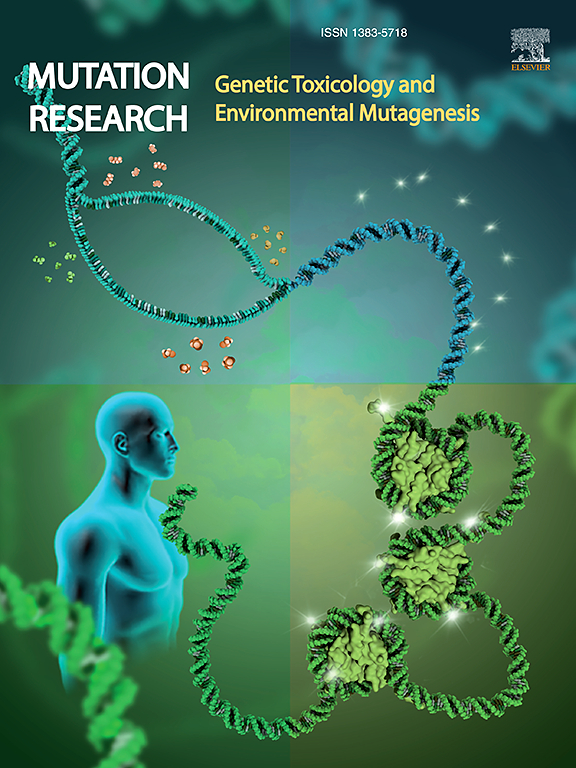低剂量双酚A加亚砷酸盐:Sprague-Dawley大鼠连续或间歇暴露对肾脏氧化应激、DNA损伤、铁下垂和纤维化的影响
IF 2.5
4区 医学
Q3 BIOTECHNOLOGY & APPLIED MICROBIOLOGY
Mutation research. Genetic toxicology and environmental mutagenesis
Pub Date : 2025-05-01
DOI:10.1016/j.mrgentox.2025.503871
引用次数: 0
摘要
砷和双酚A (BPA)是广泛存在的环境污染物。我们研究了饮用水中10 mg/L亚砷酸盐(ARS)加50µg/kg口服剂量BPA对幼年Sprague-Dawley大鼠的肾毒性。动物被随机分为七组,连续或间歇地暴露在化学物质中,持续8周。评估的参数包括尿液生物标志物、组织病理学和透射电子显微镜(TEM)检查、DNA损伤(光晕测定)和蛋白质表达。持续暴露于AS和BPA显著增加尿肌酐、白蛋白和总蛋白,降低血尿素氮(BUN)。组织病理学和透射电镜数据显示,在两个暴露组中,刷状边界脱落、铁积累、足细胞损伤、狭缝隔膜间隙增加和胶原沉积。与其他实验组相比,联合暴露组的DNA损伤明显更大。连续组和间歇组的联合暴露显示肾纤维化和铁上吊,基因表达分析显示Bax显著升高,sirt1显著降低。联合暴露比单独暴露对肾损伤的危害更大。本文章由计算机程序翻译,如有差异,请以英文原文为准。
Low-dose bisphenol A plus arsenite: Continuous or intermittent exposures in Sprague-Dawley rats; Effects on kidney oxidative stress, DNA damage, ferroptosis, and fibrosis
Arsenic and bisphenol A (BPA) are widespread environmental pollutants. We have studied the nephrotoxicity of arsenite (ARS), 10 mg/L in drinking water, plus BPA, 50 µg/kg oral dose, in juvenile Sprague-Dawley rats. Animals were randomized into seven groups and exposed to the chemicals either continuously or intermittently, for 8 weeks. The parameters evaluated were urine biomarkers, histopathological and transmission electron microscopic (TEM) examinations, DNA damage (halo assay), and protein expressions. Continuous exposure to AS and BPA significantly increased urinary creatinine, albumin, and total protein, and decreased blood urea nitrogen (BUN). Histopathological and TEM data showed brush border detachment, iron accumulation, podocyte injury, increased slit diaphragm space, and collagen deposition in both exposure groups. Significantly greater DNA damage was seen in the combined-exposure group than in the other experimental groups. Combination exposure in the continuous and intermittent groups showed renal fibrosis and ferroptosis and gene expression analysis revealed a significant increase in Bax and decrease in SIRT 1. Combination exposure was more harmful than the individual exposures in causing kidney injury in these animals.
求助全文
通过发布文献求助,成功后即可免费获取论文全文。
去求助
来源期刊
CiteScore
3.80
自引率
5.30%
发文量
84
审稿时长
105 days
期刊介绍:
Mutation Research - Genetic Toxicology and Environmental Mutagenesis (MRGTEM) publishes papers advancing knowledge in the field of genetic toxicology. Papers are welcomed in the following areas:
New developments in genotoxicity testing of chemical agents (e.g. improvements in methodology of assay systems and interpretation of results).
Alternatives to and refinement of the use of animals in genotoxicity testing.
Nano-genotoxicology, the study of genotoxicity hazards and risks related to novel man-made nanomaterials.
Studies of epigenetic changes in relation to genotoxic effects.
The use of structure-activity relationships in predicting genotoxic effects.
The isolation and chemical characterization of novel environmental mutagens.
The measurement of genotoxic effects in human populations, when accompanied by quantitative measurements of environmental or occupational exposures.
The application of novel technologies for assessing the hazard and risks associated with genotoxic substances (e.g. OMICS or other high-throughput approaches to genotoxicity testing).
MRGTEM is now accepting submissions for a new section of the journal: Current Topics in Genotoxicity Testing, that will be dedicated to the discussion of current issues relating to design, interpretation and strategic use of genotoxicity tests. This section is envisaged to include discussions relating to the development of new international testing guidelines, but also to wider topics in the field. The evaluation of contrasting or opposing viewpoints is welcomed as long as the presentation is in accordance with the journal''s aims, scope, and policies.

 求助内容:
求助内容: 应助结果提醒方式:
应助结果提醒方式:


